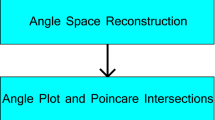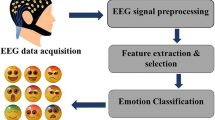Abstract
Development of algorithms for automatic detection of emotions is essential to improve affective skills of human-computer interfaces. In the literature, a wide variety of linear methodologies have been applied with the aim of defining the brain’s performance under different emotional states. Nevertheless, recent findings have demonstrated the nonlinear and dynamic behavior of the brain. Thus, the use of nonlinear analysis techniques has notably increased, reporting promising results with respect to traditional linear methods. In this sense, this work presents a review of the latest advances in the field, exploring the main nonlinear metrics used for emotion recognition from EEG recordings.
Access this chapter
Tax calculation will be finalised at checkout
Purchases are for personal use only
Similar content being viewed by others
References
Acar, S., Saraoglu, H., Akar, A.: Feature extraction for EEG-based emotion prediction applications through chaotic analysis. Turkey National Biomedical Engineering Meeting (2015)
Akar, S.A., Kara, S., Agambayev, S., Bilgiç, V.: Nonlinear analysis of EEGs of patients with major depression during different emotional states. Comput. Biol. Med. 67, 49–60 (2015)
Aravind, E., Deepak, S., Sudheer, A.: EEG-based emotion recognition using statistical measures and auto-regressive modeling. In: International Conference on Computational Intellegence & Communication Technology, pp. 587–591 (2015)
Azami, H., Escudero, J.: Amplitude-aware permutation entropy: illustration in spike detection and signal segmentation. Comput. Methods Programs Biomed. 128, 40–51 (2016)
Bandt, C., Pompe, B.: Permutation entropy: a natural complexity measure for time series. Phys. Rev. Lett. 88(17), 174102 (2002)
Blythe, D.A.J., Haufe, S., Müller, K.R., Nikulin, V.V.: The effect of linear mixing in the EEG on Hurst exponent estimation. Neuroimage 99, 377–87 (2014)
Calvo, R.A., D’Mello, S.K.: Affect detection: an interdisciplinary review of models, methods, and their applications. IEEE Trans. Affect. Comput. 1(1), 18–37 (2010)
Cao, Y., Cai, L., Wang, J., Wang, R., Yu, H., Cao, Y., Liu, J.: Characterization of complexity in the electroencephalograph activity of Alzheimer’s disease based on fuzzy entropy. Chaos 25(8), 083116 (2015)
Chanel, G., Rebetez, C., Bétrancourt, M., Pun, T.: Emotion assessment from physiological signals for adaptation of game difficulty. IEEE Trans. Syst. Man Cybern. Part A 41(6), 1052–1063 (2011)
Chen, D., Han, N., Chen, J., Guo, H.: Novel algorithm for measuring the complexity of electroencephalographic signals in emotion recognition. J. Med. Imaging Health Inform. 7(1), 203–2010 (2017)
Coan, J.A., Allen, J.J.B.: Handbook of Emotion Elicitation and Assessment. Oxford University Press, Oxford (2007)
Costa, M., Goldberger, A.L., Peng, C.K.: Multiscale entropy analysis of biological signals. Phys. Rev. E Stat. Nonlin. Soft Matter Phys. 71(2 Pt 1), 021906 (2005)
Daly, I., Malik, A., Hwang, F., Roesch, E., Weaver, J., Kirke, A., Williams, D., Miranda, E., Nasuto, S.J.: Neural correlates of emotional responses to music: an EEG study. Neurosci. Lett. 573, 52–57 (2014)
Ekman, P.: An argument for basic emotions. Cogn. Emot. 6(3–4), 169–200 (1992)
Esteller, R., Vachtsevanos, G., Echauz, J., Litt, B.: A comparison of waveform fractal dimension algorithms. IEEE Trans. Circ. Syst. I Fundam. Theory Appl. 48(2), 177–183 (2001)
Faust, O., Bairy, M.G.: Nonlinear analysis of physiological signals: a review. J. Mech. Med. Biol. 12(4), 124005 (2012)
Fernández-Caballero, A., Martínez-Rodrigo, A., Pastor, J.M., Castillo, J.C., Lozano-Monasor, E., López, M.T., Zangróniz, R., Latorre, J.M., Fernández-Sotos, A.: Smart environment architecture for emotion detection and regulation. J. Biomed. Inform. 64, 55–73 (2016)
García-Martínez, B., Martínez-Rodrigo, A., Zangróniz, R., Pastor, J.M., Alcaraz, R.: Symbolic analysis of brain dynamics detects negative stress. Entropy 19(5), 196 (2017)
García-Martínez, B., Martínez-Rodrigo, A., Zangróniz Cantabrana, R., Pastor García, J., Alcaraz, R.: Application of entropy-based metrics to identify emotional distress from electroencephalographic recordings. Entropy 18(6), 221 (2016)
Hatamikia, S., Nasrabadi, A.: Recognition of emotional states induced by music videos based on nonlinear feature extraction and SOM classification. In: 21st Iranian Conference on Biomedical Engineering (ICBME), pp. 333–337. IEEE (2014)
Hoseingholizade, S., Golpaygani, M.R.H., Monfared, A.S.: Studying emotions through nonlinear processing of EEG. Procedia Soc. Behav. Sci. 32, 163–169 (2012)
Hosseini, S.A., Khalilzadeh, M.A., Changiz, S.: Emotional stress recognition system for affective computing based on bio-signals. J. Biol. Syst. 18, 101–114 (2010)
Hosseini, S.A., Naghibi-Sistani, M.B.: Emotion recognition method using entropy analysis of EEG signals. Int. J. Image Graph. Sig. Process. 3(5), 30 (2011)
Hosseinifard, B., Moradi, M.H., Rostami, R.: Classifying depression patients and normal subjects using machine learning techniques and nonlinear features from EEG signal. Comput. Methods Progr. Biomed. 109(3), 339–345 (2013)
Jadhav, N., Manthalkar, R., Joshi, Y.: Effect of meditation on emotional response: an EEG-based study. Biomed. Signal Process. Control 34, 101–113 (2017)
Jenke, R., Peer, A., Buss, M.: Feature extraction and selection for emotion recognition from EEG. IEEE Trans. Affect. Comput. 5(3), 327–339 (2014)
Jie, X., Cao, R., Li, L.: Emotion recognition based on the sample entropy of EEG. Biomed. Mater. Eng. 24(1), 1185–92 (2014)
Kantz, H., Schreiber, T.: Nonlinear Time Series Analysis. Cambrigde University Press, Cambrigde (2003)
Khalili, Z., Moradi, M.: Emotion recognition system using brain and peripherical signals: using correlation dimension to improve the results of EEG. In: International Conference on Neural Networks, pp. 1571–1575 (2009)
Lake, D.E., Moorman, J.R.: Accurate estimation of entropy in very short physiological time series: the problem of atrial fibrillation detection in implanted ventricular devices. Am. J. Physiol. Heart Circ. Physiol. 300(1), H319–25 (2011)
Lan, Z., Sourina, O., Wang, L., Liu, Y.: Real-time EEG-based emotion monitoring using stable features. Vis. Comput. 32, 347–358 (2016)
Lee, Y.Y., Hsieh, S.: Classifying different emotional states by means of EEG-based functional connectivity patterns. PLoS ONE 9(4), e95415 (2014)
Lempel, A., Ziv, J.: On the complexity of finite sequences. IEEE Trans. Inf. Theory 22(1), 75–81 (1976)
Li, X., Qi, X., Tian, Y., Sun, X., Fran, M., Cai, E.: Application of the feature extraction based on combination of permutation entropy and multi-fractal index to emotion recognition. Chin. High Technol. Lett. 26(7), 617–624 (2016)
Li, X., Xie, J., Hou, Y., Wang, J.: An improved multiscale entropy algorithm and its performance analysis in extraction of emotion EEG features. Chin. High Technol. Lett. 25(10), 865–870 (2015)
Li, Y., Cao, D., Wei, L., Tang, Y., Wang, J.: Abnormal functional connectivity of EEG gamma band in patients with depression during emotional face processing. Clin. Neurophysiol. 126(11), 2078–2089 (2015)
Liu, Y., Sourina, O.: EEG-based subject-dependent emotion recognition algorithm using fractal dimension. In: IEEE International Conference on Systems, Man and Cybernetics, pp. 3166–3171 (2014)
Lozano-Monasor, E., López, M.T., Vigo-Bustos, F., Fernández-Caballero, A.: Facial expression recognition in ageing adults: from lab to ambient assisted living. J. Ambient Intell. Humanized Comput. 8, 567–578 (2017)
Martínez-Rodrigo, A., Fernández-Sotos, A., Latorre, J.M., Moncho-Bogani, J., Fernández-Caballero, A.: Neural correlates of phrase rhythm: an EEG study of bipartite vs. rondo sonata form. Front. Neuroinform. 11, 29 (2017)
Martínez-Rodrigo, A., Zangróniz, R., Pastor, J.M., Fernández-Caballero, A.: Arousal level classification in the ageing adult by measuring electrodermal skin conductivity. In: Bravo, J., Hervás, R., Villarreal, V. (eds.) AmIHEALTH 2015. LNCS, vol. 9456, pp. 213–223. Springer, Cham (2015). doi:10.1007/978-3-319-26508-7_21
Martínez-Rodrigo, A., Zangróniz, R., Pastor, J.M., Sokolova, M.V.: Arousal level classification of the aging adult from electro-dermal activity: from hardware development to software architecture. Pervasive Mob. Comput. 34, 46–59 (2017)
Martini, N., Menicucci, D., Sebastiani, L., Bedini, R., Pingitore, A., Vanello, N., Milanesi, M., Landini, L., Gemignani, A.: The dynamics of EEG gamma responses to unpleasant visual stimuli: from local activity to functional connectivity. NeuroImage 60(2), 922–932 (2012)
Mert, A., Akan, A.: Emotion recognition from EEG signals by using multivariate empirical mode decomposition. Pattern Anal. Appl. (2016)
Miskovic, V., Schmidt, L.A.: Cross-regional cortical synchronization during affective image viewing. Brain Res. 1362, 102–111 (2010)
Mitchell, A.J., Lord, K., Slattery, J., Grainger, L., Symonds, P.: How feasible is implementation of distress screening by cancer clinicians in routine clinical care? Cancer 118(24), 6260–9 (2012)
Murugappan, M., Nagarajan, R., Yaacob, S.: Combining spatial filtering and wavelet transform for classifying human emotions using EEG signals. J. Med. Biol. Eng. 31(1), 45–51 (2011)
Paraschiv-Ionescu, A., Buchser, E., Rutschmann, B., Aminian, K.: Nonlinear analysis of human physical activity patterns in health and disease. Phys. Rev. E Stat. Nonlin. Soft Matter Phys. 77(2 Pt 1), 021913 (2008)
Paul, S., Mazumder, N., Ghosh, P., Tibarewala, D., Vimalarini, G.: EEG-based emotion recognition system using MFDFA as feature extractor. In: International Conference on Robotics, Automation, Control and Embedded Systems (2015)
Peng, H., Hu, B., Zheng, F., Fan, D., Zhao, W., Chen, X., Yang, Y., Cai, Q.: A method of identifying chronic stress by EEG. Pers. Ubiquit. Comput. 17(7), 1341–1347 (2013)
Picard, R.W.: Affective computing (1995)
Pincus, S.M.: Approximate entropy as a measure of system complexity. Proc. Natl. Acad. Sci. USA 88(6), 2297–301 (1991)
Puthankattil, S.D., Joseph, P.K.: Analysis of EEG signals using wavelet entropy and approximate entropy: a case study on depression patients. Int. J. Med. Health Biomed. Pharm. Eng. 8(7), 420–424 (2014)
Richman, J.S., Moorman, J.R.: Physiological time-series analysis using approximate entropy and sample entropy. Am. J. Physiol. Heart Circ. Physiol. 278(6), H2039–49 (2000)
Rodríguez-Bermúdez, G., Garcia-Laencina, P.J.: Analysis of EEG signals using nonlinear dynamics and chaos: a review. Appl. Math. Inf. Sci. 9(5), 2309 (2015)
Rui, C., Li, L., Junjie, C.: Comparative study of approximate entropy and sample entropy in EEG data analysis. Biothecnol. Indian J. 7(11), 493–498 (2013)
Rukavina, S., Gruss, S., Hoffmann, H., Tan, J.W., Walter, S., Traue, H.C.: Affective computing and the impact of gender and age. PLoS ONE 11(3), e0150584 (2016)
Russell, J.A.: A circumplex model of affect. J. Pers. Soc. Psychol. 39(6), 1161–1178 (1980)
Russell, J.A., Bachorowski, J.A., Fernandez-Dols, J.M.: Facial and vocal expressions of emotion. Ann. Rev. Psychol. 54, 329–49 (2003)
Schröder, M., Cowie, R.: Towards emotion-sensitive multimodal interfaces: the challenge of the European network of excellence HUMAINE. In: Adapting the Interaction Style to Affective Factors Workshop in conjunction with User Modeling (2005)
Sourina, O., Liu, Y.: A fractal-based algorithm of emotion recognition from EEG using arousal-valence model. In: Proceeding of the International Conference on Bio-Inspired Systems and Signal Processing, pp. 209–214 (2011)
Sporns, O., Tononi, G., Edelman, G.M.: Theoretical neuroanatomy: relating anatomical and functional connectivity in graphs and cortical connection matrices. Cereb. Cortex 10(2), 127–141 (2000)
Tadic, B., Gligorijevic, V., Mitrovic, M., Suvakov, M.: Co-evolutionary mechanisms of emotional bursts in online social dynamics and networks. Entropy 15(12), 5084–5120 (2013)
Valenza, G., Lanata, A., Scilingo, E.P.: The role of nonlinear dynamics in affective valence and arousal recognition. IEEE Trans. Affect. Comput. 3(2), 237–249 (2012)
Wang, X., Nie, D., Lu, B.: Emotional state classification from EEG data using machine learning approach. Neurocomputing 129, 94–106 (2014)
Yuvaraj, R., Murugappan, M., Ibrahim, N.M., Sundaraj, K., Omar, M.I., Mohamad, K., Palaniappan, R.: Optimal set of EEG features for emotional state classification and trajectory visualization in Parkinson’s disease. Int. J. Psychophysiol. 94(3), 482–95 (2014)
Zhang, Y., Ji, X., Zhang, S.: An approach to EEG-based emotion recognition using combined feature extraction method. Neurosci. Lett. 633, 152–157 (2016)
Acknowledgments
This work was partially supported by Spanish Ministerio de Economía, Industria y Competitividad, Agencia Estatal de Investigación (AEI)/European Regional Development Fund under Vi-SMARt (TIN2016-79100-R), HA-SYMBIOSIS (TIN2015-72931-EXP) and EmoBioFeedback (DPI2016-80894-R) grants. Beatriz García-Martínez holds the FPU16/03740 scholarship from Spanish Ministerio de Educación, Cultura y Deporte.
Author information
Authors and Affiliations
Corresponding author
Editor information
Editors and Affiliations
Rights and permissions
Copyright information
© 2017 Springer International Publishing AG
About this paper
Cite this paper
García-Martínez, B., Martínez-Rodrigo, A., Alcaraz, R., Fernández-Caballero, A., González, P. (2017). Nonlinear Methodologies Applied to Automatic Recognition of Emotions: An EEG Review. In: Ochoa, S., Singh, P., Bravo, J. (eds) Ubiquitous Computing and Ambient Intelligence. UCAmI 2017. Lecture Notes in Computer Science(), vol 10586. Springer, Cham. https://doi.org/10.1007/978-3-319-67585-5_73
Download citation
DOI: https://doi.org/10.1007/978-3-319-67585-5_73
Published:
Publisher Name: Springer, Cham
Print ISBN: 978-3-319-67584-8
Online ISBN: 978-3-319-67585-5
eBook Packages: Computer ScienceComputer Science (R0)




